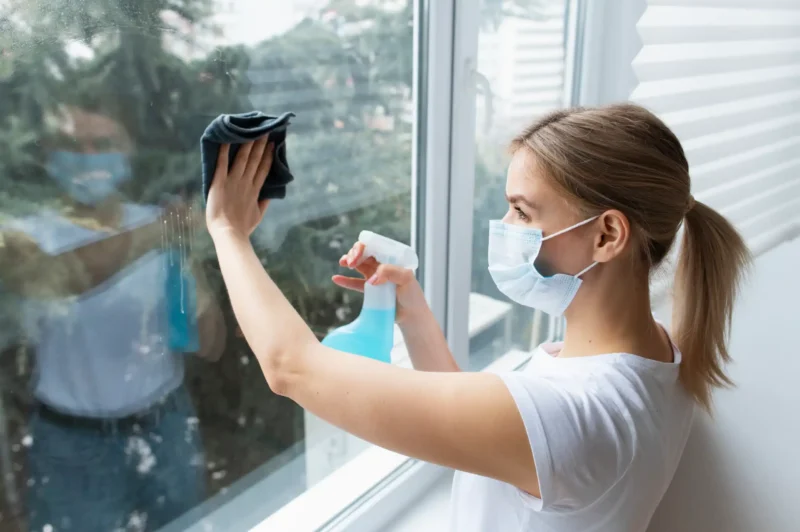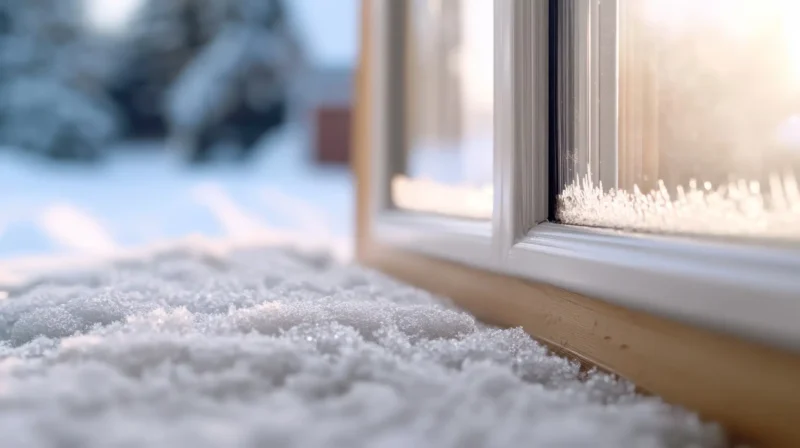First, you noticed a musty smell. You couldn’t place it until your usual home cleaning routine. While wiping down your window, you spotted the “enemy” – tiny black spots dotting the corner of the frame. Mold around windows is a common issue in Boston. Mold “loves” moisture and warmth, and Boston’s humid continental climate provides the perfect conditions.
Many people overlook mold, but if left unchecked, it can trigger serious health issues. These include various allergic reactions, respiratory problems, and infections that may lead to severe diseases. Common symptoms of mold exposure include coughing, runny nose, unexplained headaches, irritated eyes and skin, fatigue, weakness, skin rashes, and even breathing difficulties or asthma.
Contrary to popular belief, mold isn’t only black or dark green. It can appear in various colors, including:
- Red
- White
- Yellow
- Brown
- Green
- Black
- Pink
You should pay attention to the problem, as mold can spread rapidly. Once mold spores find a suitable environment, they can quickly evolve and grow. It’s crucial to address mold cleaning as soon as possible. Understanding the origins of mold growth is key to keeping your windows mold-free and your home healthy.
Top 5 Causes of Mold Around Windows?
Understanding the common factors that lead to mold growing on windows is crucial for maintaining a healthy home environment. Mold typically appears on window sills, frames, corners, and edgеs and can spread to nearby walls and ceilings when ignored. It can grow between window panes and even on glass in specific conditions.
Let’s explore the top five causes of mold around windows:
- Condensation
Condensation is a primary cause of mold on windows, especially during colder months. It occurs when warm, moist indoor air meets the cold surface of the window, causing water vapor to turn into liquid. Common types of mold on windows from condensation include green, black, and brown.
- Leaky Windows
Water infiltration through gaps and cracks in leaky windows creates an ideal environment for mold growth. This issue can lead to hidden mold penetrating deeper into walls and frames, potentially causing structural damage that requires professional mold remediation.
Window leaks can result from worn-out materials, improper installation, damaged seals, clogged drainage holes, or design flaws. Typically, mold caused by leaks appears black, green, or brown.
- High Indoor Humidity
Indoor humidity plays a crucial role in maintaining a healthy living environment. Various factors contribute to high indoor humidity, including climate, daily activities such as showering and cooking, leaks, and insufficient heating systems. Black, green, yellow, and brown mold types thrive in these conditions.
- Poor Ventilation
Inadequate ventilation traps moisture and creates an ideal environment for mold development. When humid air can’t escape, it accumulates on cooler surfaces like windows. Black mold on windows, along with green and brown, are common sights in poorly ventilated spaces.
- Accumulation of Dust and Organic Material
Dust and organic material provide a food source for mold spores. When dust accumulates on windows, it absorbs moisture from the air and creates the perfect environment for black, green, and brown mold growth.
How to Prevent Mold on Windows?
Understanding the causes of mold growth on windows is crucial for effective prevention and management. Let`s focus on the particular things you can undertake to protect your home from unwanted mold.
The first step is to identify the reason for the mold’s appearance. Once you have addressed the issues, you can begin cleaning the affected areas of the windows.
Cleaning Mold – Step by Step Guide
- Gather Supplies:
- Protection – rubber gloves, mask, and goggles to protect yourself from mold spores.
- Cleaning agents – white vinegar, hydrogen peroxide, or a commercial mold remover.
- Scrubbing tools: a scrub brush or an old toothbrush for hard-to-reach areas.
- Disposable cloths or paper towels for wiping and disposal.
- Prepare the Area: Ensure good ventilation by opening windows or using fans. Isolate the area to prevent the spread of mold spores to other parts of the home.
- Apply Cleaning Solution: Choose the best product for your situation and spray it generously on the moldy areas.
- Let the Solution Sit: Allow the cleaning solution to sit on the mold for about an hour. This gives it time to break down the mold structure.
- Scrub and Clean: Use a scrub brush or toothbrush to remove the mold, especially in corners and crevices.
- Dry the Area: Thoroughly dry the window area to prevent future mold growth. Mold thrives in moist environments, so keeping the area dry is key.
- Dispose of Cleaning Materials: To prevent the spread of spores, discard used cloths and any mold-contaminated materials in a sealed plastic bag.
Prevention is Better than Cure
Preventing mold growth around windows involves managing moisture and ensuring proper maintenance.
- Control Indoor Humidity
Open windows for a few minutes daily to improve humidity levels naturally. Ventilation helps reduce humidity and prevent moisture from settling on windows. If this method isn`t effective enough, especially during humid seasons, consider using dehumidifiers.
- Regular Cleaning and Maintenance
Include regular dusting and cleaning of window areas — sills, frames, and glass — in your weekly home cleaning routine. Pay special attention to edges and corners.
When you notice condensation on windows, wipe it away promptly with a dry cloth. Don’t ignore it, as this prevents moisture accumulation.
- Address Leaks
Check your windows regularly for leaks or damaged seals. Repair any cracks and gaps to prevent water intrusion, which can lead to mold growth.
If you’re experiencing repeated problems, take notice of them. Consider replacing your older windows or those with improper installation to prevent future issues.
By implementing these strategies, you can effectively prevent mold on window frames, sills, panes, and other areas, maintaining a healthy indoor environment.
Consider Hiring a Professional
Mold around windows, especially black mold, is a serious issue that can lead to severe health problems. In certain situations, hiring professional mold cleaning services is necessary to protect your home and family from unwanted complications.
Professional assistance is crucial when:
- Mold extends beyond the window area, affecting walls or other structural components and potentially causing serious damage.
- You’ve attempted to clean mold yourself, but it keeps returning, indicating an underlying moisture problem.
- Mold is present in hard-to-access areas, such as inside walls or under window frames, requiring professional equipment and expertise for effective treatment, etc.
Our team at Windows Cleaning Expert is competent in the specific challenges posed by mold on windows. We utilize innovative equipment that can enhance the longevity of your windows. Our pressure and power washing methods can permanently solve mold problems without relying on excessive chemicals.
By choosing us, you’re not just addressing a current mold issue – you’re investing in the long-term health and safety of your home.
FAQ
- Can mold grow on glass?
Mold doesn`t technically grow on the glass itself. However, it can appear on glass surfaces if there`s a build-up of dust and organic material that mold can feed on.
- How to get rid of mold on windows?
First, identify the cause of the mold`s appearance, then clean it. Use protective gear, appropriate cleaning agents, and a brush or scrub. After treating the affected area, ensure it’s thoroughly dried and well-ventilated.
- What causes mold on windows?
It might be caused by condensation, poor ventilation, build-up dust and organic materials, or leaky windows.




